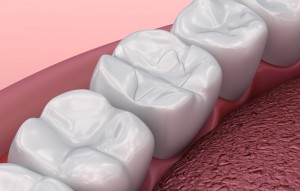Dental Sealants
Our back molar teeth sometimes suffer decay on the top surface, despite our best effort to brush and clean our teeth. This is because the top surface of these molar teeth is indented and grooved. This rough tooth surface is beneficial for chewing, but the small spaces here can be hard to clean. The pits and grooves on the top of our molars may be smaller than the bristles of our toothbrushes, so food and bacteria in these spaces are difficult to remove. This leads to tooth decay.
Devices like Waterpik can help clean these small spaces on the molars. Mouthwash can help too. But most of us don’t have a Waterpik, and even mouthwash cannot remove all the debris. So other preventative means against decay must be used.
The problem in cleaning these molar teeth seems to be more prevalent in children who still have their baby teeth.
Sealants
Dental sealants can help prevent decay on the back molar teeth. These sealants fill in the small spaces on the top of the molars, so there are fewer places for food and bacteria to be trapped. It is a relatively easier task to clean out the larger spaces.
Dental sealants will not fill in the large indentations on the back molars, so chewing is not affected.
Dental sealants developed over the course of the 20th century. Modern sealants are based on resin or glass ionomers. They are applied to the molars once the surface has been slightly roughened with acid etching, and quickly harden.
Ongoing research shows that sealants greatly reduce the amount or serious decay in back molar teeth. Newer sealants that contain fluoride seem to be even more effective than earlier types of sealants.
Dental sealants are reasonably straightforward to apply, and last for several years; 5 to 10 years is not uncommon. With children, the sealants will usually last as long as the baby’s teeth, so any new sealants will be applied to the permanent teeth.
Unfortunately, it is not possible to apply sealants to the other teeth in the mouth. Sealants only work on the rough surface of the back molars. The smooth surface of the front teeth will not hold a sealant. But as these smooth surfaces are much easier to clean the application of a sealant would not be appropriate or necessary.
Carlingford Dental
If you or your children have problems keeping the back molars clean then talk to your Carlingford Dentist about sealants for these back teeth.
Information Disclaimer
The content of this article is meant for informational purposes only and should not be considered a source of professional advice, recommendations, or endorsements. It is not a substitute for seeking expert guidance or making well-informed decisions based on individual circumstances. Although we strive for accuracy and reliability, we cannot guarantee the information's completeness or suitability for all situations. Readers are urged to verify facts, consult experts, and consider their own context before taking actions or decisions based on this content. No warranties, explicit or implied, are provided regarding the accuracy, timeliness, or completeness of the presented information. Relying on this information is at the reader's own discretion and risk. We encourage readers to consult relevant professionals or experts for advice tailored to their specific needs. Neither the author, publisher, nor any affiliated parties will be held responsible for errors, omissions, or damages resulting from the use or reliance on the information in this article.

